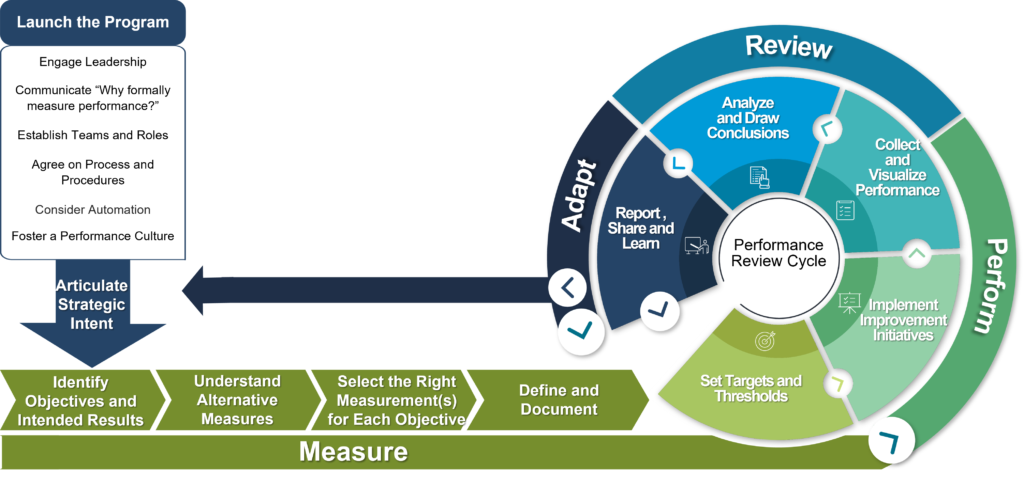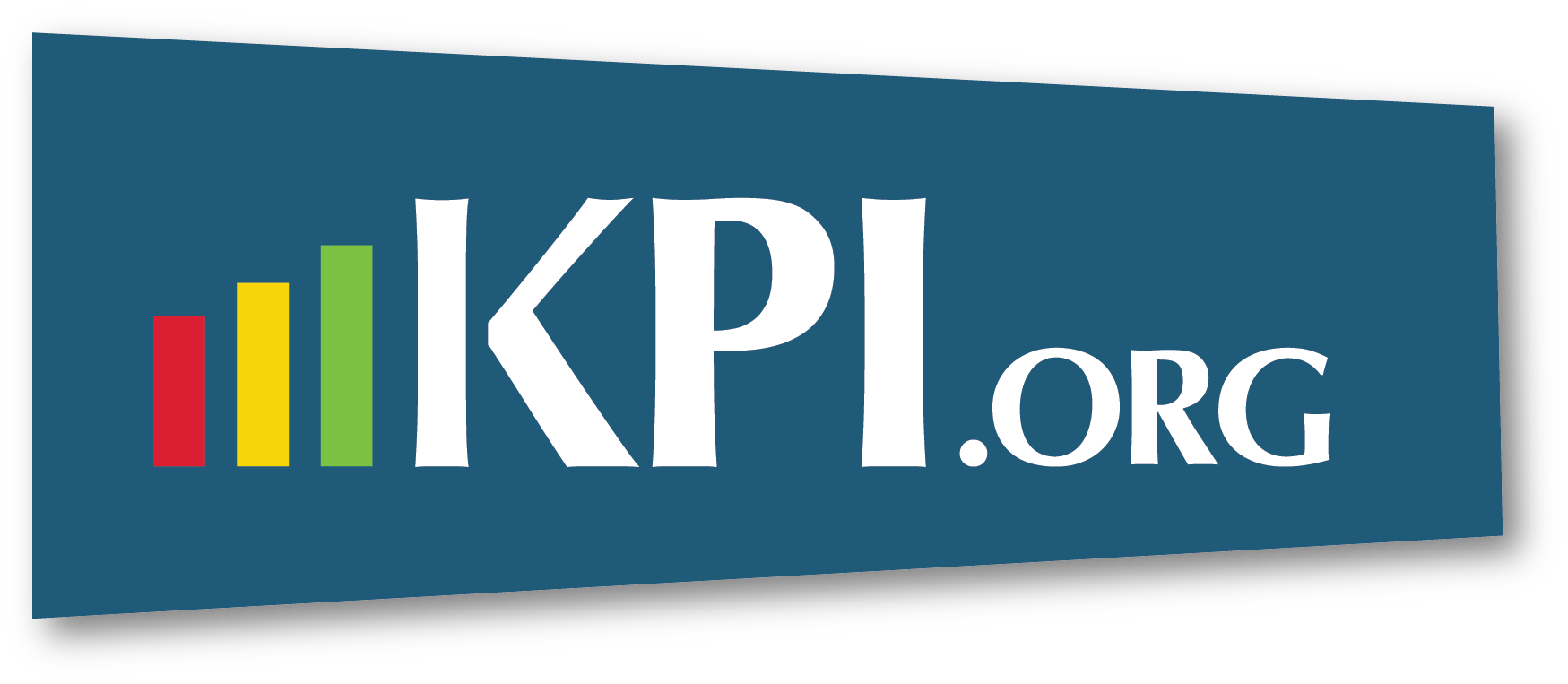HOW TO DEVELOP KPIS / PERFORMANCE MEASURES
The Balanced Scorecard Institute’s (BSI) Measure-Perform-Review-Adapt (MPRA) framework is a disciplined, practical, and tested approach for developing and implementing a KPI system. It gives organizations a way to systematically articulate a shared vision of what you are trying to achieve, set practical goals, develop meaningful indicators that can be managed and used for decision-making, and establish long-term discipline around getting things done.

These practical step-by-step methodologies and tools were designed to help organizations:
-
- Select and design performance measures that are far more meaningful than simple brainstorming or benchmarking can produce
- Get buy-in from staff and stakeholders to enthusiastically own performance measurement and improvement
- Bring measures to life in a consistent way, using the right data and with the right ownership
- Design insightful and actionable reports and dashboards that focus discussion on improvement
- Convincingly hit performance targets, and make measurement about transformation
Measurement development is only the starting point for the improvement process. Once measures have been established, the Perform-Review-Adapt cycle gives the organization a chance to take improvement actions, assess impact, and adapt. Adaptation can take the form of incremental reforecasting for the next quarter or more dramatic changes in strategic intent. Rather than “setting and forgetting” their KPIs, teams use this review cycle as the discipline needed to keep their teams on track and adjust to changes in their strategic environment. It borrows the key principle from the agile world that assumes that we cannot possibly know everything about our strategic intentions at the beginning of the process and so need a disciplined learning process.
Always begin by articulating your strategy properly. Use one of the many popular frameworks for strategy or goal setting (Balanced Scorecard, SMART, MBO, OKRs, WIGs, or other) to set objectives/goals and determine your strategy for achieving them. If you don’t know what you are trying to accomplish, it is too early for KPIs!
Pre-Measurement
Launch the Program
The program is launched by project champion(s) and key stakeholders. Existing measurement materials and results are examined, a performance management good practice gap analysis is completed, key stakeholders are interviewed, and other assessment activities are completed to customize workshops to incorporate work done to date. Key activities covered during the program launch include:
-
- Engaging Leadership
- Communicating “Why formally measure performance?”
- Establishing Teams and Roles
- Agreeing on Process and Procedures
- Considering Automation
- Fostering a Performance Culture
Articulate Strategic Intent
Before discussing measures of success, first one must understand what you are trying to accomplish. Even the most narrowly focused operational activities can be more efficient by better communicating intent. We recommend using one of the many popular frameworks for strategy or goal setting (e.g., Balanced Scorecard, SMART, MBO, OKRs, WIGs, or other) to structure the conversations around goals and your strategy for achieving them. If you don’t know what you are trying to accomplish, it is too early for KPIs!
Measure
There are four process components within the measurement development phase of the MPRA framework:
-
- Identify objectives and intended result(s)
- Understand alternative measures
- Select the right measurement(s) for each objective
- Define and document selected performance measures
Identify Objectives and Intended Results
The development of meaningful measures starts with Objectives. The building blocks of strategic intent, Objectives are the linchpins of a successful KPI system, whether it is focused on strategy or operations. Objectives are qualitative, continuous improvement actions (outcomes) critical to strategy success. Once the objective is identified, unambiguous intended result(s) of the objective are defined. Once agreement is reached on the 0bjective and intended result, it’s easier to explicitly define what to measure.
Understand Alternative Measures
Once the objective and intended result are clear, alternative measures can be identified. The first option includes any direct measure of the intended result. If the intended result cannot be measured directly, more indirect measures will be identified, usually by analyzing measurable components of the objective based on a hypothesis around correlation or contribution to the result. The logic model, cause-effect analysis and/or process flow analysis are three popular tools that can be used to better understand measurable components before selecting indirect measurements.
Select the Right Measure(s) for Each Objective
Narrow down the potential measures identified in the previous steps and select final measures using a disciplined system that scores options based on their relative strength and data availability. Choose metrics that have meaning and relevance, and:
-
- Answer key user questions about the organization’s performance towards strategic objectives
- Provide information needed to make better strategic decisions
- Are valid and verified, measuring what is intended
- Encourage desirable employee behaviors
- Avoid an undue data collection burden or unintended consequences
Define and Document Selected Performance Measures
The Performance Measure Data Definition Table is used to document the essential information comprising every performance measure on a scorecard. This is a critical step for transitioning from performance management system development to implementation and use. It is important to document the details of the measure so that the measure is consistently calculated and presented from reporting period to reporting period, allowing for more meaningful performance analysis and conclusions.
Perform
The performance review cycle follows a regular pattern (usually quarterly) organized around a simple pattern: set targets, implement improvement actions, track performance, and learn from the results. In the Perform phase employees organize their activities around two process components:
-
- Set Targets and Thresholds
- Implement Improvement Initiatives
Set Targets and Thresholds
Describing desired performance levels and determining how data is interpreted is as important as selecting the measure. Performance is based on targets, the desired level of performance for a specific reporting period, and thresholds, the upper and lower limits of desired performance around a target value. Thresholds create the exact points where an indicator displays green for good performance, yellow for satisfactory or red for poor.
Implement Improvement Initiatives
The team will generally not achieve objectives and hit performance targets without taking action. Actions or improvement initiatives are developed, prioritized, and implemented to achieve objectives. Rather than create a long list of potential actions and projects, the organization focuses on a short list of experiments designed to make the biggest difference in desired outcomes.
Review
In the Review phase of the process, data is transformed into evidence-based knowledge and understanding. The Review phase is organized around two process component steps:
-
- Collect and Visualize Performance
- Analyze and Draw Conclusions
Collect and Visualize Performance
Gathering and tracking data on the historic levels and current trends in performance encompasses more than just counting things and capturing data. Creating meaningful visual comparisons enables deeper interpretation and better decisions. Visualizing performance over time identifies trends that show data direction and development and provide context for the underlying story relative to strategic intent.
Analyze and Draw Conclusions
Effective analysis helps people make better decisions that will drive improved strategic outcomes. The key is to evaluate the effect of each improvement action on an ongoing basis using the same principles and methods deployed in the earlier steps, monitor performance data for the desired signals relative targets and thresholds, enable dialog around conclusions, and maintain a continuous process improvement focus.
Adapt
The Adapt phase of the process explores whether improvement strategies were effective and correctly executed, and if assumptions turned out to be valid. It includes an assessment of quarterly performance results, which can lead to a reforecasting of performance targets, a new set of actions or initiatives, or a complete recalibration of strategy, as needed. Sometimes the Adapt phase leads to the continuation of current activities and sometimes it means refocusing Strategic Intent based on a changing strategic environment. This phase focuses on identifying what worked well and what didn’t, taking corrective action and becoming a high-performance organization.
Report, Share, and Learn
Reporting and sharing information are the first steps toward making better decisions and acting on the information in a way that improves overall performance. Review meetings are held to review, interpret, and discuss performance information. These meetings are organized around desired results and highlight progress toward the intended results, as well as towards actions designed to improve gaps in performance. This gives the team an ongoing indication of whether actions taken are effective. The information and knowledge from this process should continuously feed the strategic planning cycle.
Unlock Your Organization’s Potential with Expert KPI Consulting
Are you struggling to develop meaningful KPIs or align them with your strategy? Do you need help improving communication and decision-making across your organization? Our expert KPI consulting services are here to guide you.
Take the First Step Today:
- Start from Scratch: Don’t know where to begin? Contact us for a free overview session to get started.
- Improve Existing KPIs: Already have some KPIs in place? Let us help you connect the dots and enhance your current system.
- Build Buy-In: Engage your team with our facilitation services to ensure everyone is on board with your KPI strategy.
- KPI Training: Enhance your team’s skills with our comprehensive KPI training programs, designed to equip you with the knowledge and tools needed to develop and manage effective KPIs.
- Assess Your Maturity: Use our interactive Strategic Management Maturity Model (SMMM) for a quick self-assessment of your organization’s strategic management.
- QuickStart™ Your KPI System: Get your team trained and facilitated through our MPRA framework with our QuickStart™ KPI consulting services.
Contact Us Now to learn more about how our tailored consulting services can help you achieve success in implementing your KPI, Dashboard, Balanced Scorecard, or Strategy Execution.

